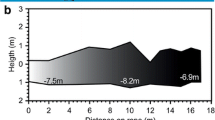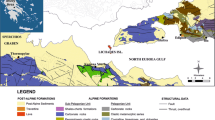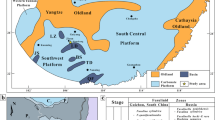Abstract
Subaerial Quaternary limestones exposed on raised beach terraces on the Atlantic coastline north of Casablanca, Morocco, are undergoing rapid denudation by fungal and cyanobacterial destructive processes. Erosion is accomplished by penetration of the substrate by mycelia, including dissolution of carbonate substrate which subsequently becomes trapped in the biofilms in the photic zone along the terraces. The cyanobacteria cause biophysical disintegration, redistribution and biosynthesis of mineral components. Invasion of the pore space created by cyanobacteria is followed by microbially mediated carbonate cementation, beginning with the precipitation of several generations of crystallographically diverse carbonate cements. The micro-caves exhibit a range of features dominated by speleothemic calcite, microborings, algal filaments, hyphae, and calcite spherulites, which support the role of micro-organisms in the bioerosion and subsequent cementation of carbonate rocks in the terrestrial environment.
Similar content being viewed by others
References
ALEXANDERSSON, T., 1972, Micritization of carbonate particles: Processes of precipitation and dissolution on modern shallow-marine sediments:Bulletin of the Geological Institute, University of Uppsala, Sweden, v. 7, p. 201–236.
BRACHERT, T.C., 1999, Non-skeletal carbonate production and stromatolite growth within a Pleistocene Deep Ocean (Last Glacial Maximum, Red Sea):Facies, v. 40, p. 211–228.
BUCZYNSKI, C. and CHAFETZ, H.S., 1990, Habit of bacterially induced precipitates of calcium carbonate and the influence of medium viscosity on mineralogy:Journal of Sedimentary Petrology, v. 61, p. 226–233.
CALLOT, G., GUYON, A., and MOUSAIN, D., 1985, Interrelations entre aiguilles de calcite et hyphes myceliens:Agronomie, v. 5, p. 209–216.
CALVET, F. and JULIA, R., 1983, Pisoids in the caliche profiles Tarragona, north east Spain,in T.M. Peryt, ed., Coated Grains, Springer Verlag, Berlin, p. 456–473.
CHAFETZ, H.S. and GUIDRY, S.A., 1999, Bacterial shrubs, crystal shrubs, and ray-crystal shrubs: bacterial vs. abiotic precipitation:Sedimentary Geology, v. 126, p. 57–74.
CHAFETZ, H.S., and BUCZYNSKI, C., 1992, Bacterially induced lithification of microbial mats:Palaios, v. 7, p. 277–293.
CHAFETZ, H.S., RUSH, P.F., and UTECH, N.M., 1991, Microenvironmental controls on mineralogy and habit of CaCO3 precipitates: an example from an active travertine system:Sedimentology, v. 38, p. 107–126.
CHAFETZ, H.S. and FOLK, R.L., 1984, Travertines: Depositional morphology and the bacterially constructed constituents:Journal of Sedimentary Petrology, v. 54, p. 289–316.
COX, G., JAMES, J.M., LEGGETT, K.E.A., OSBORNE, R., ARMSTRONG, L., 1989, Cyanobacterially deposited speleothems: subaerial stromatolites:Geomicrobiology Journal, v. 7, p. 245–252.
DEFARGE, C., TRICHET, J., JAUNET, A., ROBERT, M., TRIBBLE, J., and SANSONE, F., 1996, Texture of microbial sediments revealed by cryo-scanning electron microscopy:Journal of Sedimentary Research, v. 66, p. 935–947.
EMEIS, K.C., RICHNOW, H.H., and KEMPE, S., 1987, Travertine formation in Plitvice National Park, Yugoslavia: Chemical versus biological control:Sedimentology, v. 34, p. 595–609.
FOLK, R.L., 1993, SEM imaging of bacteria and nannobacteria in carbonate sediments and rocks:Journal of Sedimentary Petrology, v. 63, p. 990–999.
FOLK, R.L., ROBERTS, H.H., and MOORE, C.H., 1973, Black phytokarst from Hell, Cayman Islands:Geological Society of America Bulletin, v. 87, p. 2351–2360.
GOMES, N.A. De N.C., 1985, Modern stromatolites in a karst structure from the Malmani Subgroup, Transvaal Sequence, South Africa:Transactions of the Geological Society of South Africa, v. 88, p. 1–9.
HOSE. L.D., PALMER, A.N., PALMER, M.V., NORTHUP, D.E., BOSTON, P.J., and DuCHENE, H.R., 2000, Microbiology and geochemistry in a hydrogen-sulphide-rich karst environment:Chemical Geology, v. 169, p. 399–423.
JAMES, N.P., 1972, Holocene and Pleistocene calcareous crust (caliche) profiles: criteria for subaerial exposure:Journal of Sedimentary Petrology, v. 42, p. 817–836.
JONES, B., 1989, The role of microorganisms in phytokarst development on dolostones and limestones, Grand Cayman, British West Indies:Canadian Journal Earth Sciences, v. 26, p. 2204–2213.
JONES, B., 1988, The influence of plants and microorganisms on diagenesis in caliche: example from the Pleistocene Ironshore Formation on Cayman Brac, British West Indies:Bulletin of Canadian Petroleum Geology, v. 36, p. 191–210.
JONES, B. and KAHLE, C.F., 1986, Dendritic calcite crystals formed by calcification of algal filaments in a vadose environment:Journal of Sedimentary Petrology, v. 56, p. 217–227.
KAHLE, C.F., 1977, Origin of subaerial Holocene calcareous crusts: role of algae, fungi and sparmicritization:Sedimentology, v. 24, p. 413–435.
KLAPPA, C.F., 1979a, Calcified filaments in Quaternary calcretes: organo-mineral interactions in the subaerial vadose environment:Journal of Sedimentary Petrology, v. 49, p. 955–968.
KLAPPA, C.F., 1979b, Lichen stromatolites: criterion for subaerial exposure and a mechanism for the formation of laminar calcretes (caliche):Journal of Sedimentary Petrology, v. 49, p. 387–400.
KRUMBEIN, W.E. and GIELE, C., 1979, Calcification in a cocooid cyanobacterium associated with the formation of desert stromatolites:Sedimentology, v. 26, p. 593–604.
KRUMBEIN, W.E. and STAL, L.J., 1991, The Geophysiology of Marine Cyanobacterial Mats and Biofilms:Kieler Meeresforsch, v. 8, p. 158–163.
LEVEILLE, R.J., FYFE, W.S., and LONGSTAFFE, F.J., 2000, Geomicrobiology of carbonate-silicate microbialites from Hawaiian basaltic sea caves:Chemical Geology, v. 169, p. 339–355.
LILJEDAHL, L., 1985, Endolithic micro-organisms and silification of a bivalve fauna from the Silurian of Gotland:Lethaia, v. 19, p. 267–278.
MACINTYRE, I.G. and REID, R.P., 1995, Crystal alteration in a living calcareous alga (Halimeda): Implications for studies in skeletal diagenesis:Journal of Sedimentary Research, v. A65, p. 143–153.
MERZ, M.U.E., 1992, The Biology of carbonate precipitation by cyanobacteria:Facies, v. 26, p. 81–102.
PENTECOST, A., 1978, Blue-green algae and freshwater carbonate deposits:Proceedings of the Royal Society of London, v. B200, p. 43–61.
PENTECOST, A. and BAULD, J., 1988, Nucleation of calcite on the sheaths of Cyanobacteria using a simple diffusion cell:Geomicrobiology Journal, v. 6, p. 129–135.
REITNER, J., 1993, Modern cryptic microbialite/metazoan facies from Lizard Island (Great Barrier Reef, Australia). Formation and concepts:Facies, v. 29, p. 3–40.
SAADI, M., HILALI, E.A., BENSAID, M., BOUDDAI, A., and DAHMANI, M., 1985, Carta Geologique du Maroc.Notes de Memoir 260. Royaume du Maroc, Ministere de L’Energie et des Mines.
SCHNEIDER, J., 1976, Biological and inorganic factors in destruction of limestone coasts:Contributions to Sedimentology, v. 6, p. 1–112.
SCHNEIDER, J., 1977, Carbonate construction and decomposition by epilithic and endolithic micro-organisms in salt- and freshwater,in, Fluugel, E., Editor,Fossil Algae, Springer-Verlag, Berlin, p. 248–260.
SMITH, B.J., WARKE, P.A., and MOSES, C.A., 2000, Limestone weathering in contemporary arid environments: a case study from southern Tunisia:Earth Surface Processes and Landforms, v. 25, p. 1343–1354.
VERRECCHIA, E.P., FREYTET, P., VERRECCHIA, K.E., and DUMONT, J-L., 1996, Spherulites in calcrete laminar crusts: Biogenic CaCO3 precipitation as a major contributor to crust formation — Reply:Journal of Sedimentary Research, v. 66, p. 1041–1044.
VERRECCHIA, E.P., FREYTET, P., VERRECCHIA, K.E., and DUMONT, J-L., 1995, Spherulites in calcrete laminar crusts: biogenic CaCO3 precipitation as a major contributor to crust formation:Journal of Sedimentary Petrology, v. A65, p. 690–700.
VISSCHER, P.T., REID, R.P., BEBOUT, B.M., HOEFT, S.E., MACINTYRE, I.G., and THOMPSON, J.A., 1998, Formation of lithified micritic laminae in modern marine stromatolites (Bahamas): The role of sulfur cycling:American Mineralogist, v. 83, p. 1482–1493.
WEBB, G.E., 1998, Earliest known Carboniferous shallow-water reefs, Gudman Formation (Tn1b), Queensland, Australia: Implications for Late Devonian reef collapse and recovery:Geology, v. 26, p. 951–954.
WESTALL, F. and RINCE, Y., 1994, Biofilms, microbial mats and microbe-particle interactions: Electron microscope observations from diatomaceous sediments:Sedimentology, v. 41, p. 147–162.
WINSBOROUGH, B.M. and GOLUBIC, S., 1987, The role of diatoms in stromatolite growth: Two examples from freshwater settings:Journal of Phycology, v. 23, p. 195–201.
WRIGHT, V.P., PLATT, N.H., and WIMBLETON, W.A., 1988, Biogenic laminar calcretes: evidence of calcified root-mat horizons in palaeosols:Sedimentology, v. 35, p. 603–620.
WRIGHT, V.P., 1986, The role of fungal biomineralization in the formation of Early Carboniferous soil fabrics:Sedimentology, v. 33, p. 831–838.
WRIGHT, V.P., 1989, Terrestrial stromatolites and laminar calcretes: a review:Sedimentary Geology, v. 65, p. 1–13.
YATES, K.K. and ROBBINS, L.L., 1998, Production of carbonate sediments by a unicellular green alga:American Mineralogist, v. 83, 1503–1509.
Author information
Authors and Affiliations
Corresponding author
Rights and permissions
About this article
Cite this article
Duane, M.J. Biomineralization and phytokarst development on cavernous Quaternary carbonate terraces, Mohammedia, northwest Morocco. Carbonates Evaporites 16, 107–116 (2001). https://doi.org/10.1007/BF03175829
Received:
Accepted:
Published:
Issue Date:
DOI: https://doi.org/10.1007/BF03175829




